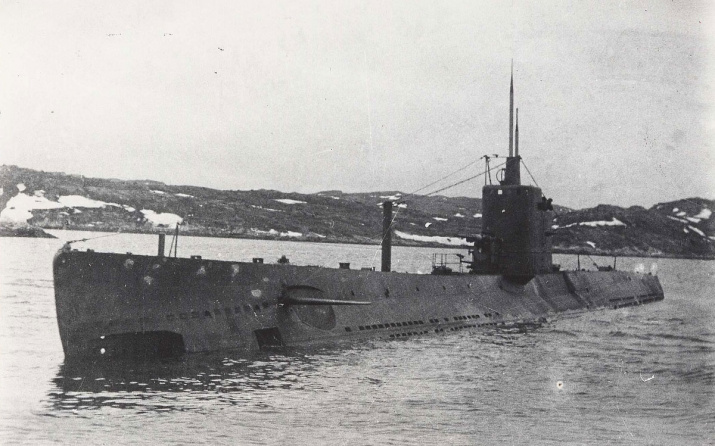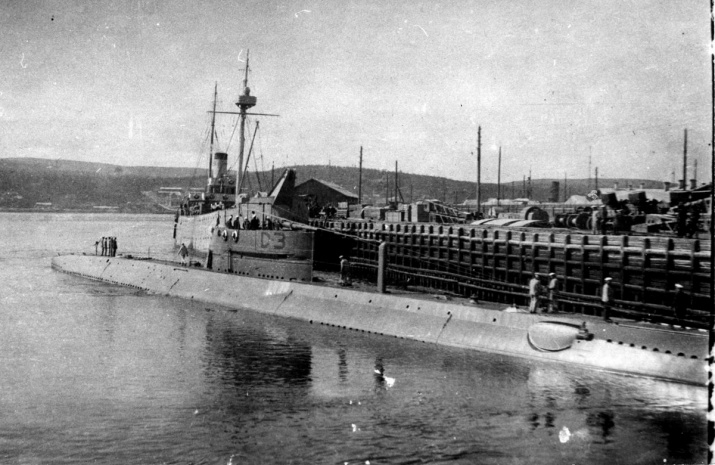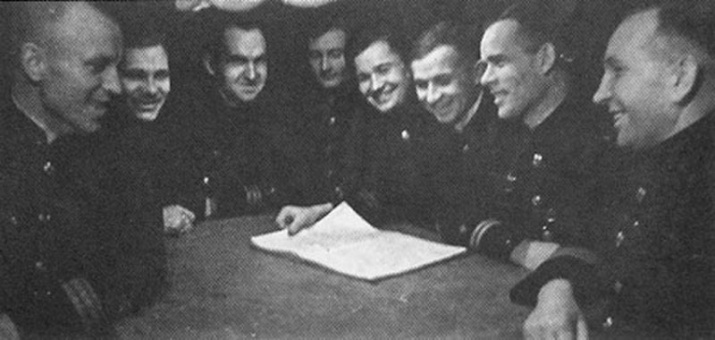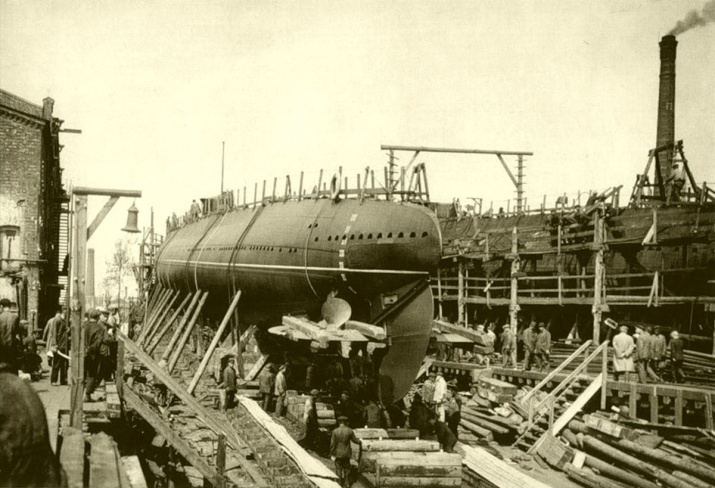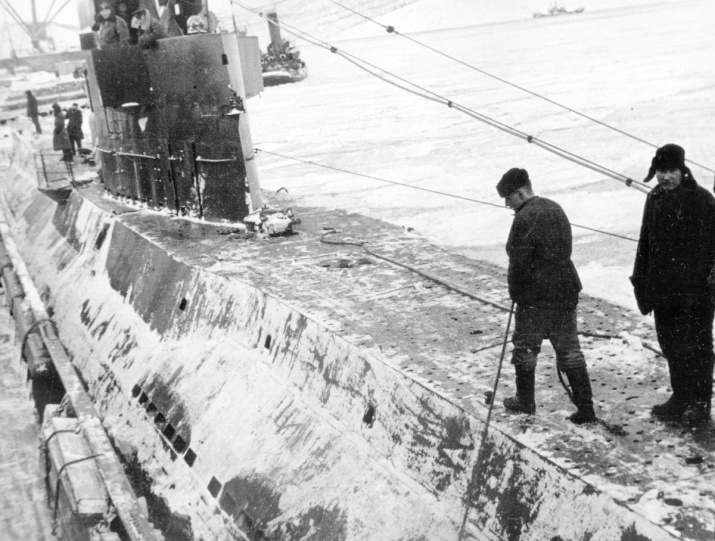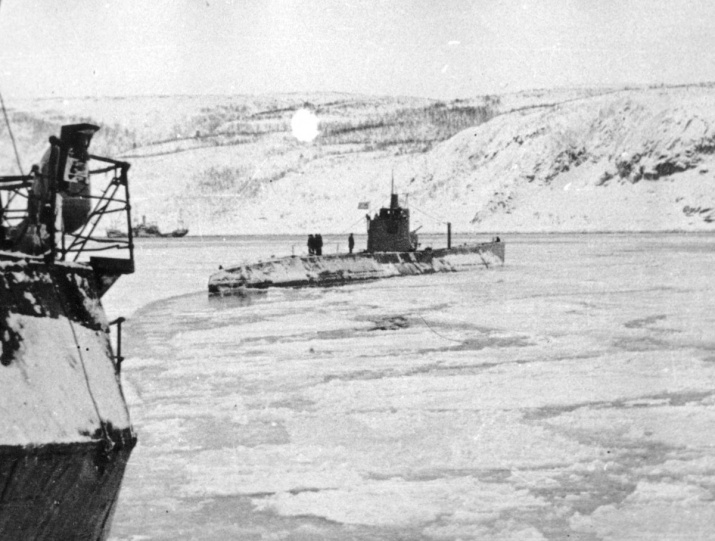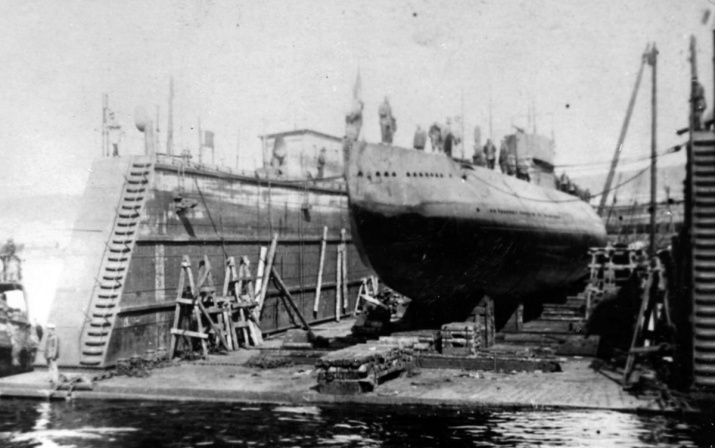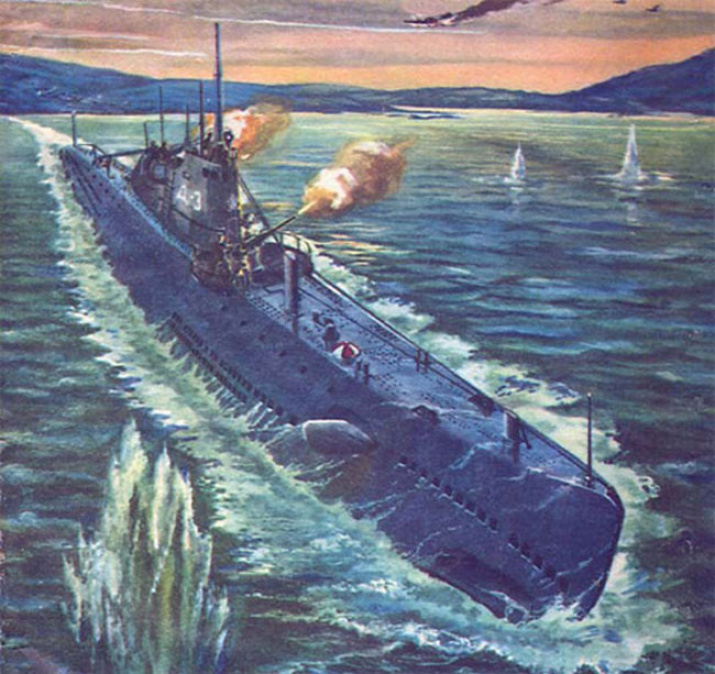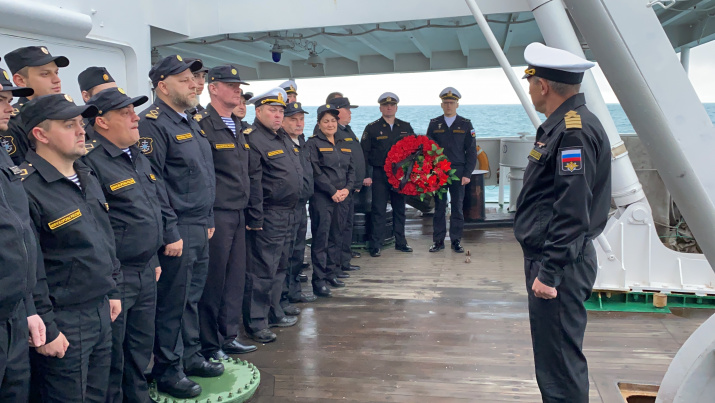D-3 submarine
Historical information
D-3 "Krasnogvardeyets" submarine of the I class
Based on the publications of M. Morozov
(information taken from the sovboat.ru website with corrections and additions)
It was laid down on March 5, 1927 at plant No. 189 (Baltic Plant) in Leningrad under construction number 179. The ceremony of laying the ship was attended by the head of the Leningrad Communists, S. M. Kirov.
On July 12, 1929, the submarine was launched and on November 14, 1931 became part of the Baltic Sea Naval Forces. The cost of the construction amounted to 2 million 685 thousand rubles in the prices of 1926 - 1927.
K.N. Griboyedov was appointed the first commander of the submarine.
In the summer of 1933, the submarine as part of the Special purpose expeditions made the transition from the Baltic to the North along the newly built White Sea-Baltic Canal, becoming the core of the nascent Northern Fleet. On September 21, 1933, the Krasnogvardeets joined the Northern Military Flotilla.
In September 1934, the boat received the letter-numeric designation D-3, but the old name continued to be used both in everyday life and in official documents.
In 1937, D-3, together with D-2, made a high-latitude voyage to Medvezhy Island and the Svalbard Bank, covering a total of 3,673 miles.
In February 1938, the submarine participated in the removal of the polar station "SP-1" led by D.I. Papanin. The Krasnogvardeets was located next to the Papanin's ice floe and provided communication between icebreaking vessels and the main fleet base. The submarine was commanded by Senior Lieutenant D.N. Kotelnikov, on board were the commander of the submarine brigade, captain of the 1st rank K.N. Griboyedov, the navigator of the brigade, senior lieutenant F.V. Konstantinov and the flagship mechanic military engineer of the 3rd rank V.I. Rybakov. In the Greenland Sea, D-3 crossed the prime meridian and was the first of the Soviet submarines to enter the western hemisphere. On February 13, 1938, for the first time in the history of underwater navigation, the submarine passed under the Arctic ice, forcing a 5-cable ice bridge separating it from clear water. In October 1938, Krasnogvardeyets moved to the Baltic Plant, where it was undergoing major repairs and modernization. By April 1940, the work was completed – the contours of the light hull were changed on the submarine, the structure of the wheelhouse fence was replaced, the main caliber gun was replaced, and new means of communication were installed.
D-3 met the beginning of the Great Patriotic War under the command of a lieutenant commander Philip Konstantinov as part of the Northern Fleet's 1st submarine division in the Motka bay according to the combat training plan.
On the evening of June 23, 1941, D-3 entered the Porsanger Fjord area (position No. 3). On board the boat, the commander of the division, Captain of the 3rd rank M.I. Gadzhiyev, went out to sea as a provider.
During the campaign, the Krasnogvardeyets twice detected the periscopes of enemy submarines, which at that moment were not yet in the North. A dozen times she had to dodge enemy planes by going underwater urgently. All the time the submarine was in position, it was at a sufficient distance from the shore, when the routes of the enemy ships passed in coastal waters. As a result, the signalers of the submarine only once observed masts on the horizon, it was not possible to get close to them. Soon the submarine was withdrawn from the position and in the evening of July 4 moored in Polarny.
On the evening of July 17, D-3 went to sea again. This time on board the submarine was the commander of the 3rd submarine division, to which the submarine was transferred, captain of the 3rd rank Ivan Kolyshkin. The submarine was to operate in the Lopp Sea (position No. 2). All the time being in the specified area, the Krasnogvardeets was pursued by a series of breakdowns. The resulting carbon residue did not allow the diesel valves to work properly. As a result, during an hour of movement in the underwater position, the submarine took up to a ton of seawater, which filled the hold of the diesel compartment to the top. The water was pumped out, the valves were repaired, but the log failed, and then the upper head of the commander's periscope began to pass water. On the morning of July 25, the submarine was recalled to the base, where on July 28 it got up for navigation repairs. On the afternoon of August 12, when D-3 was in Olenya Bay, she was attacked by enemy aircraft. One of the planes was shot down by return fire from the 45-mm gun of the submarine, which was headed by starshina 1st class (equivalent to the petty officer 1st class) A.P. Beregovoy. On this day, the 5th Air Fleet lost one Bf-110C from the ZG76 squadron.
From left to right: Military Commissar senior politruk E.V. Gusarov, navigator, Senior Lieutenant E.M. Berezin, commander of the BCH-5, Lieutenant Commander-engineer V.A. Chelyubeyev, commander of the motor group, Lieutenant-engineer N.K. Ryabov, military paramedic V.I. Shibanov, commander of the mine-torpedo unit B.S. Donetskiy, assistant commander of the submarine Lieutenant Commander P.D. Sokolov, commander of the ship captain 3rd rank M.A. Bibeev.
On the morning of August 16, D-3 went on the third combat campaign. The submarine was to operate in the Vardø area (position No. 5). On the evening of August 19, D-3 discovered an enemy convoy consisting of the transports Sivas (3832 grt), Donau (2931 grt), Rotenfels (7854 grt), Barmbek (2446 grt) and Stamsund (864 grt) in the protection of the training ship Bremse, destroyers Z-7 and Z-20 and the patrol ship Gote. While preparing another offensive on Murmansk, the enemy was transferring units of the 6th Mountain Division to Kirkenes. The technical condition of the ship was such that, despite the repairs that had just been carried out, when launching an attack, the submarine hardly kept the depth. Before the salvo, the horizontal operator midshipman S. Nescheret still "drowned" the periscope, and a single torpedo shot was made blindly. The enemy did not notice the attack, the torpedo passed by. On August 25, D-3 detected an enemy convoy, but could not attack, as she did not have time to go on a combat course due to the temporary failure of the vertical rudder. On September 7, 1941, the boat returned to the base.
The command was dissatisfied with the actions of the commander of D-3, although much depended on the technical condition of the ship, which left much to be desired - in addition to the diesel valves, the hydrophones of an old noise direction finding station let water through. The submarine itself had to undergo warranty repairs in the summer of 1941, which was never carried out.
The fourth D-3 combat campaign was provided by the division commander I.A. Kolyshkin and the head of the political department of the submarine brigade, regimental commissar A.P. Baykov. On the evening of September 22, the submarine entered the Tana Fjord-Bos Fjord area (position No. 4). During this patrol, D-3 had to try out a new method of torpedo firing, when the attacking submarine fired not one, but two or three torpedoes, which gave the greatest opportunity to hit the target. For shooting with a "time interval", the commander took with him a set of special tables. The first contact with the enemy took place on the morning of September 26 in Kongs Fjord. The submarine fired two torpedoes at a single vessel, according to the commander's estimate of 1,500 - 2,000 tons. Two minutes after the torpedoes left the submarine, a strong explosion was heard on D-3. Seven minutes later, the submariners tried to see the result of the attack through the periscope, but the snow did not allow them to do this. The Germans deny the loss of any of their ships in the area of operations of D-3 at this time. A small Norwegian coaster was probably attacked. It is possible that the explosion occurred when the torpedo hit the bottom or coastal rock. Nevertheless, the submarine considered the target sunk.
The next day, in the area of Gamvik, the submarine found an enemy destroyer (at that time, a convoy of the hospital ship Berlin 15286 grt, which much later became the infamous Admiral Nakhimov, destroyers Z-16, Z-20, trawlers M-18, M-22 and M-30, was passing here). The submarine began maneuvering for a torpedo attack, but at that moment it turned out that it was impossible to open the covers of the aft torpedo tubes, which were intended for firing, because the valve and stem connecting the trim tank and the tubes of the torpedo tubes were disconnected. The target was missed. A few hours later, D-3 found a single vessel of 1,500 - 2,000 tons, identified as a tanker, since its superstructure was located in the stern. After the launch of one torpedo, there was no explosion, but three minutes later it was observed through the periscope that the ship was going under the water. Raising the periscope after another five minutes, the commander did not observe the target. The ship was considered sunk. Obviously, this time again it was a Norwegian coaster that was attacked. In those five minutes the coaster managed to get out of sight.
On the afternoon of September 30, north of Omgang, D-3 found two single vessels diverging in countercourses. A plane was circling above them. A vessel with a displacement of 2,000 – 3,000 tons was chosen for the attack, going eastwards. The submarine fired three torpedoes from a distance of 8-9 cable lengths. According to the memoirs of the commander of the Krasnogvardeyets, after the torpedoes left the submarine, a high-pressure air main burst in the central post. The piercing whistle made ears hurt, so no one heard the explosions. Five minutes after the attack, only one transport moving westwards was observed through the periscope. For the submariners, this was the reason to record another victory on their account. The enemy also leaves this D-3 attack without comment.
A few hours later, the submarine tried to attack a convoy consisting of transports "Bravo I" (1585 grt), "Stella" (479 grt) and the tanker "Oyrland" (869 grt) under the protection of the patrol "Celle", "Gote" and chasers Uj-1205, Uj-1701. Going out on a combat course D-3, navigating using the periscope, ran aground, although according to the map, the depth in this place was 26 m. The emergency submarine was facing the shore. At the suggestion of the chief of the political department on board, D-3 surfaced, turned around and sank again. Fortunately, such a maneuver went unnoticed by the enemy, but the moment for the attack was missed.
Met by D-3 on the afternoon of October 1, a convoy consisting of the hospital ship Stuttgart (13387 grt) under the protection of destroyers Z-16, Z-20 and trawlers M-18, M-22, M-30, R-155, R-162 arrived in Kirkenes without losses. The submarine considered itself detected by one of the escort ships, and the attack failed. Soon the cable of the commander's periscope broke. It froze in the extreme upper position, so in the event of a torpedo attack, the boat would certainly have been detected. Disputes broke out among the authorities. Some wanted to return to the base, others were not satisfied with this option, they insisted that the ship remain in position. A few days later, the crew carried out a complex of labor-intensive work, the cable was replaced with a mooring rope, the periscope was repaired.
D-3 continued patrolling and on the afternoon of October 11, north of Cape Seibunes, discovered a convoy including transport "Georg L. M. Ruess" (2980 grt), the tanker "Hermann Andersen" (1171 grt) under the protection of the trawlers M-17 and M-29. The submarine fired three torpedoes in pursuit of the vessel, estimated by the commander to be 5-6 thousand tons. After one and a half to two minutes, two explosions were heard on the submarine and the target was considered hit, but the attacked convoy arrived in Kirkenes without losses.
On October 13, in Tana Fjord, the "Krasnogvardeyets" got into a net, from which she was able to free herself only an hour later. On October 14, the noise direction finder failed on D-3 – water got inside the vibrators. On the same day, due to a sudden deterioration in visibility, the submarine was unable to attack a convoy consisting of the motor ships Harmut (2713 grt) and Mar del Plata (7333 grt) under the protection of the destroyer Z-20 and the trawlers M-18, M-22. On the night of October 16, D-3 was recalled to the base and arrived in Polyarny the next day.
The submarine was credited with four victories. The total tonnage of the sunk vessels was 10 - 13 thousand tons. Despite this, the command was extremely dissatisfied with the actions of the commander of D-3. According to the reports of the support, during the combat campaign, the commander of D-3 showed indecision, confusion and nervousness. They recommended appointing a new commander to the submarine. As a result, Konstantinov was removed from his post and sent as part of a military mission to England, and a lieutenant commander Mikhail Bibeev (then a captain of the 3rd rank) was appointed in his place.
At that time, D-3 was in the Murmansk dock. The submarine required serious repairs. The commander of the division, who went to sea on the Krasnogvardeyets, noted in his report that there was a constant leak of diesel valves on the submarine and the passage of water into the bow trim tank. The last combat trip of the submarine was accompanied by a breakdown of the commander's periscope, a failure of the log, a breakdown of the filling valve of torpedo tubes, poor operation of the direction finder and unreliable operation of the echo sounder. The task was seriously hampered by the lack of acoustics on the submarine.
On November 11, D-3 completed repair work and on the afternoon of November 22, she went to the area of Cape Nordkap (position No. 3). In this combat campaign on board the submarine were the division commander Kolyshkin and the assistant commander, Senior Lieutenant P.D. Sokolov, who was seriously injured (during repair work when removing the commander's periscope, two fingers on his left hand were torn off), the divisional miner, Lieutenant Commander A.M. Kautsky. Soon after going to sea, the submariners were able to assess the quality of the repairs carried out. In the evening of November 22, the foremost horizontal rudders failed – the roller of disconnecting the rudders from the spire broke, then the wire suspension of the gyrocompass broke. The rudders were already put into operation on November 24, but the repair of the gyrocompass was impossible while out in the sea. Remembering the experience of his predecessor, the new commander ventured to continue navigation using the magnetic compass. On the morning of November 24, D-3 occupied the specified area, having a divergency of 60 miles to the west. Finally, the submarine arrived at the mouth of the Porsanger Fjord, where it could specify its location by coastal landmarks. Since the echo sounder worked unreliably, the submarine could not calculate by the nature of the depth change, so it kept within sight of the shore, at the same time not coming too close to it.
Nevertheless, the submarine tried to enter the Porsanger Fjord. On the second attempt it was possible to do it. On November 28, the submarine discovered a convoy in Honninsvog Bay and attacked a 6,000-ton vessel with three torpedoes. A minute later, an explosion was recorded on the submarine and the target was considered hit, but according to the enemy, the convoy consisting of the steamships Ludwig (1065 grt), Aldebaran (7891 grt), the tanker Erling Linde (1281 grt) under the escort of the Kiaochau and Togo patrol ships that left Honningsvog on that day did not suffer losses. D-3 herself could not observe the result of its attack through a periscope, since too much water was taken into the equalizing tank at the time of the shot, and the submarine sank to a depth of 66 meters.
On the afternoon of December 5, northeast of Cape Sverholtklubben, D-3 attacked a 10,000-ton transport from the convoy. A minute after the launch of the torpedoes, two explosions thundered. The submarine was under the periscope, but the snow that began did not allow to observe the result of the attack. Continuing to follow the convoy, D-3, an hour after the attack, observed through the periscope only the mast, pipe and part of the aft superstructure of the target, which disappeared from view after a few minutes. This time, the Krasnogvardeyets attacked a convoy consisting of the transports Leuna (6856 grt) and Feodosia (3075 grt) under the protection of the trawlers M-17 and M-30, which did not suffer losses.
A day later, in the same area, another caravan was attacked by D-3. It included the Ringar motor ship (5013 grt), the Moshill transport (2959 grt) in the protection of the Nordrif and Nordwind patrol ships. A minute after the torpedoes were launched, an explosion was heard on the submarine. Observing the result of the attack through a periscope, the commander, according to him, saw how one of the escort ships removed people from the dying ship, which went under water, turning stern up. In fact, this convoy arrived at its destination without losses. According to many Soviet sources, the victim of this attack was the tanker Abraham Lincoln, with a displacement of 9570 grt. It is not entirely clear how propagandists from the political department imagined a vessel with this name as part of the Nazi fleet, but the only transport at that time bearing the name of the US president sailed under the Norwegian flag and was in British freight. The displacement of this cargo ship was 5,740 grt. The ship survived the war, and was sold for scrapping to Japan in 1962.
On December 15, 1941, D-3 returned to the base. According to the results of the last campaign, she was credited with the destruction of three enemy transports with a total displacement of 24,000 tons (according to the results of 1941 - seven transports of 36,000 tons - the first place in the number of sunk ships among Soviet submarines). The commander of the submarine was awarded the Order of the Red Banner, Commander of the Division Kolyshkin, who repeatedly went out to sea on the Krasnogvardeyets, was presented with the title Hero of the Soviet Union.
On December 21, the Krasnogvardeets moved to the Murmansk plant of the People's Commissariat of the Fishing Industry, where the submarine was to get routine repairs. There, the submariners learned that on January 17, 1942, by Decree of the Presidium of the Supreme Soviet of the USSR, the submarine D-3 was awarded the Order of the Red Banner "for exemplary performance of combat missions of the command during the fight against the German invaders and the valor and courage shown at the same time." By the beginning of February, the repair work was completed, and the submarine was back in service.
On February 22, 1942, the Krasnogvardeyets went on the sixth combat campaign in the Tana Fjord area (position No. 4). The opportunity to attack did not present itself immediately. On February 24, the submarine missed targets twice. In the morning, due to poor visibility, D-3 failed to attack an unidentified vessel. In the afternoon, due to a sudden change in the course of the target, it was not possible to launch a torpedo at a group of minesweepers or hunters. On the afternoon of February 27, the Krasnogvardeets discovered a convoy consisting of transports Taiwan (5502 grt), Nerva (1564 grt), tanker Liselotte Esberger (1593 grt) under the protection of the patrol ships Polarzonne, Polarmeer, Ubir and trawler M-1507. The submarine did not have time to go on a combat course, and before the eyes of the submarine commander, the caravan entered Mehamn. The submarine did not wait for the convoy somewhere east of the port, so when two hours later the caravan continued to Kirkenes, the submarine could only wave it good-bye. After that, D-3 entered the Mehamn Fjord twice, but there were no enemy vessels there. At the same time, the submarine repeatedly touched the bottom – as a result it bent the fence of the vertical rudder. Now she began to shift with a noticeable effort. On March 3, again, due to a sudden change in the target's course, the submarine failed to attack a group of minesweepers.
On March 8, 1942, D-3 was withdrawn from the position to cover the Allied convoy PQ-12 (position "B"). After spending two days in the cover position, on March 11, the Krasnogvardeyets follows to the rescue of the SHCH-402, which was left without fuel off the enemy coast. K-21 came to the aid the fastest, and on March 13, D-3 received an order to go to the previous position in the area of Tana Fjord. On the afternoon of March 14, east of Gamvik, the submarine attacked a convoy transport with two torpedoes. A minute later, an explosion was recorded on the submarine. According to the enemy, a convoy consisting of the transport "Vardø " (860 grt), "Homborgzund" (253 grt) was currently in the area under the protection of the trawlers M-1502, M-1504 and the patrol ship "Cherusker" and a combination of ships including the "Brummer" and "Cobra" minelayers, the "Polarkrais" patrol ship and chasers Uj-1108, Uj-1109. The minelayers had 200 drifting mines on board, which were intended to create a "Bantos-A" barrier off the northeast coast of the Rybachy Peninsula. At 13.38, the BV-138 flying boat, which was barraging over the connection of the ships, detected the presence of a submarine. The seaplane dropped three 50 kg bombs on the submarine, and the ships, having received the notification, turned so that their sterns were facing the submarine. At this time, the trawler M-1504 from the convoy escort found a trace of a torpedo that crossed the ship's wake 50 m away. The detected submarine was subjected to a two-hour pursuit by chasers which dropped 34 depth charges on the submarine, from the close explosions of which the kingston of the equalizing tank was damaged on D-3 and water began to flow into the central post through the burst glass of the water measuring column. The position of the submariners was unenviable: the submarine received negative buoyancy, and all attempts to keep it at a certain depth led to nothing. It was also impossible to turn on a very noisy pump for pumping water – the chasers continued to search for the submarine. D-3 risked skipping the extreme depth and being crushed by water pressure. Fortunately, the pursuit soon stopped.
On the evening of March 14, 1942, the commander of the boat received the "go-ahead" to return to base. On the morning of March 16, due to a navigational error, instead of Kildin Island, the submarine went to Cape Vyevnavolok, where, hitting the ground, damaged the palting of the main ballast tanks and broke the underwater part of the log. A few hours later, the D-3 arrived in Polyarny and soon arrived in Murmansk for emergency navigation repairs.
On April 3, 1942, by order of the People's Commissar of the Navy, the submarine D-3 became a Guards submarine.
On May 2, 1942, the "Krasnogvardeyets" re-enters the position. This time, the submarine was to operate in the area northwest of Vardø (position No. 5). On board was the chief of staff of the Northen Fleet submarine brigade, Captain of the 1st rank Boris Skorokhvatov. Already in the evening of May 2, east of Cape Harbaken, D-3 attacked a 6000-ton transport from the convoy. Explosions were heard on the boat, and 10 minutes later the commander of the boat observed the ship with a roll to starboard and trim to the bow through the periscope (torpedoes were fired into the left side of the transport). According to the enemy, a convoy consisting of the transports Algol (972 grt) and Juris (3.323 grt), which were guarded by the patrol ships V-5902, V-5904 and V-5906, was attacked. The convoy arrived at its destination without losses.
The next attack of D-3 took place on May 16 at Cape Makkaur. 75 and 90 seconds after the launch of the torpedoes, explosions were heard on the submarine, but this time, according to the enemy, the convoy attacked by D-3 including the motor ship Knute Nelson (5749 grt), the steamers Kaupanger (1584 grt) and Frigga (557 grt), tankers Algol (972 grt) and Oleum (476 grt) under the escort of the V-5906, V-6103 , V-6107 and V-6114 patrol ships suffered no losses.
The next day, east of Cape Makkaur, a convoy consisting of the motor ship "Hallingdal" (3180 grt) and the transport Tijuca (5918 grt), which was under a fairly strong escort of patrol ships V-5901, V-5902, V-5905, V-6108, NM-01 and chasers Uj-1102, Uj-1105, Uj-1106, was attacked by D-3. Two explosions were recorded on the submarine, which gave the submarine commander a reason to declare upon returning to base about a successful attack on a transport with a displacement of 12,000 tons. According to the enemy, traces of two torpedoes were observed 3-10 m astern of the V-5901 patrol ship, three torpedoes passed between the V-5902 stem and the Tijuca stern. A group of chasers turned around to search for the submarine, but failed, so there was no bombing. Meanwhile, D-3 managed to leave the dangerous area. Soon the submarine arrived at the base.
Upon returning from the campaign, the submarine commander reported the sinking of three enemy transports with a total displacement of 26,000 tons.
On June 10, 1942 D-3 left on its last combat mission with the task of patrolling the Tana Fjord area (position No. 4). By this time, the boat had a fully decorated crew, mainly consisting of candidates or members of the CPSU. After that nobody heard from D-3 again and she did not return to the base. Along with the boat, 53 members of its crew were also killed.
D-3 was the first ship of the USSR Navy to achieve the Guards rank and become a Red Banner at the same time.
As established by the results of the work of the Northern Fleet in recent years, the submarine was sank by a mine of the Bantos-A barrage, which was set on March 20, 1942 by the Brummer and Cobra minelayers, which safely avoided torpedoes from D-3 a week before the mine laying.
Eight combat campaigns:
22.06.1941 - 04.07.1941
17.07.1941 - 28.07.1941
16.08.1941 - 07.09.1941
22.09.1941 - 17.10.1941
22.11.1941 - 15.12.1941
22.02.1942 - 16.03.1942
02.05.1942 - 18.05.1942
10.06.1942
Results:
According to official Soviet data, D-3 accounts for eight enemy ships sunk with a total displacement of 28140 grt and damage to one transport of 3200 grt. The success of any attack is not confirmed by captured documents of the German Navy.

